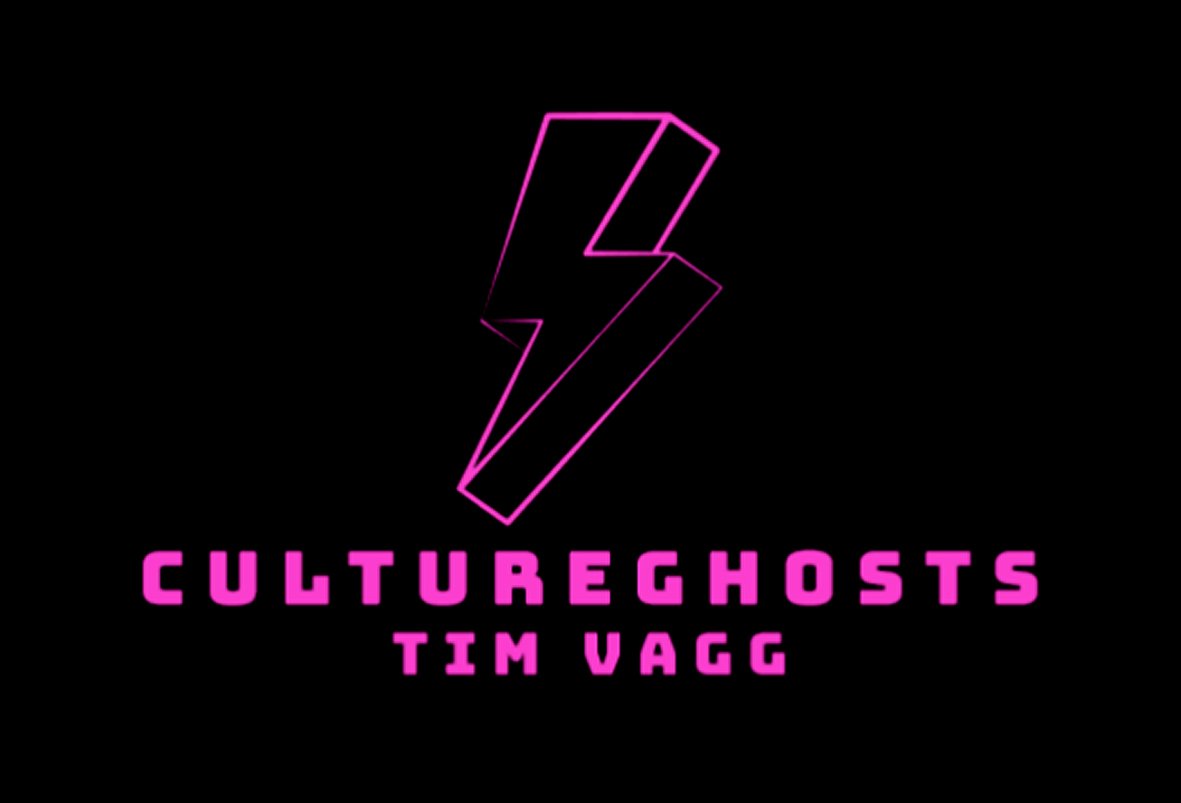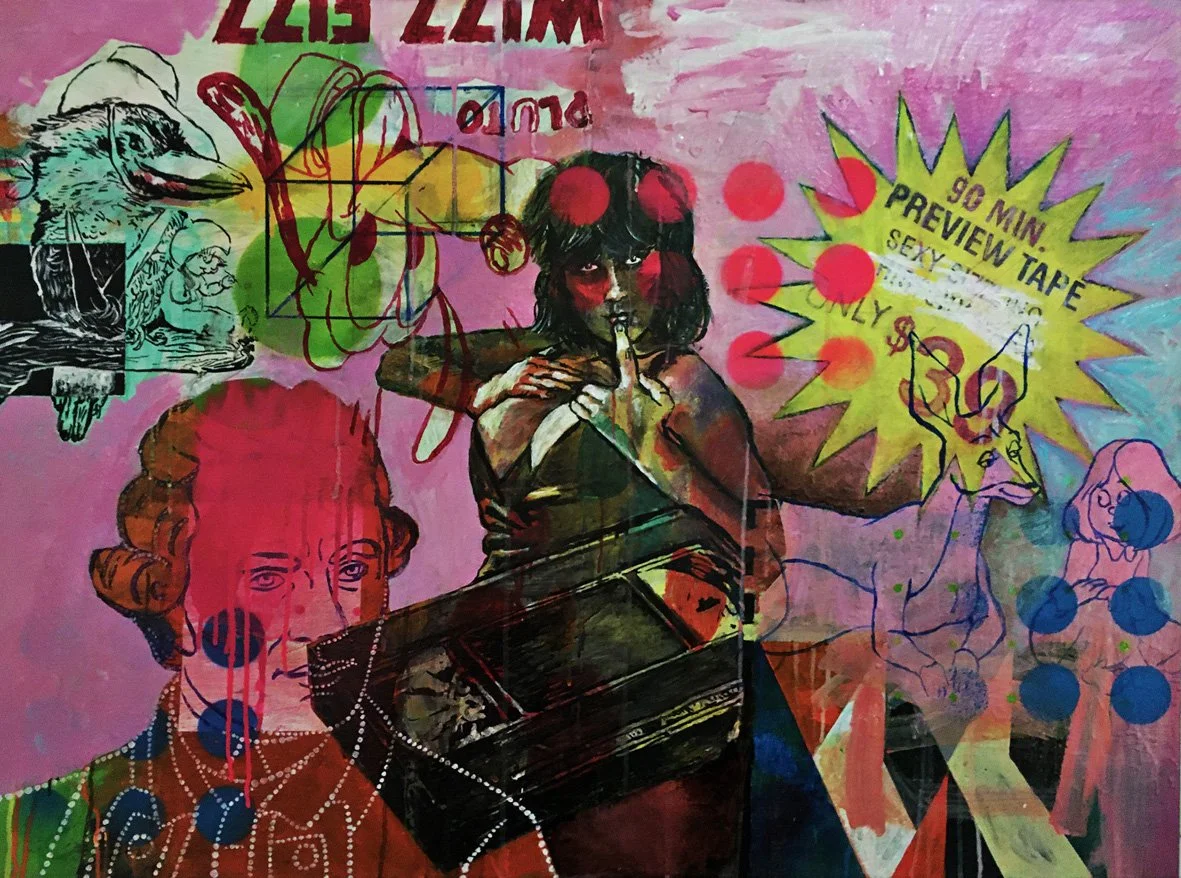
SHAMO 2023 synthetic polymer paint and mixed media on polycotton 122 x 122 cms SOLDBE IN IT 2023 synthetic polymer paint and mixed media on polycotton 122 x 92 cms
WIZZ FIZZ 2023 synthetic polymer paint and mixed media on polycotton 106 x 82 cms
Cultureghosts is a body of work began in 2021. The work, dominated by imagery of Australian popular culture of the 1970's and 1980's, explores the visual impact this imagery has had on the artists childhood psyche and how myths and perceptions of history and national identity are formed, experienced and result in the erasure of other histories.
The images are drawn from visual fragments from magazines such as Australasian Post and are juxtaposed with various historical images from Pictorial Social Studies text books of the era. The image fragments are often juxtaposed so the images are both simultaneously familiar and disorienting.
The artist is a direct descendant of First Fleet convicts Lydia Munro and Andrew Goodwin, and a distant relative of Patrick Howard, a hero of Eureka. A passion, fascination and engagement with Australian history and identity, drives an on-going conversation ever present within the artists practice.
The artists previous exhibitions, since the 1990's has interrogated the inherent contradictions, grotesques and absurdities in visual representations of a colonial white national identity.
Many of the works are literally dotted with a series of dots or ellipsis, which work not only as a compositional device, but also suggest a pause or omission of speech in both writing and histories. The trace of a moment of silent thought or a story erased. It could be suggested that the information might be understood from the contextual clues around it, eluding to a hidden sub-text lurking behind the crass adverting imagery and slogans. The dots or dotted line also could suggest First Nations dot painting, or maybe the dots on the maps of the colonisers?
The figurative elements that populate the paintings are drawn from random imagery remembered from a childhood exposure to magazines, television, educational books and advertising of the late 1970's and early 1980's growing up in Ballarat and rural Victoria. The various characters, figures and faces, some taken from crossword cartoon strips featured in Australasian Post magazine, suggest the artists interest in them as possible emotional ciphers, or as a kind of 'Greek chorus' involved in some psychological play, asking the viewer to comment on our psycho-social condition as consumers of not only images as culture, but us as vessels or a projection surface for some other subjectivity.
The Australasian Post was read by millions at the height of its popularity in the 1970s, and featured a uniquely Australian mix of scandal, sensationalism, human interest stories, fashion, politics, culture and entertainment, being the staple of barber shops across the country, such as where the artist first encountered them as a child at a former barber shop only a few shops away from the where the Art Gallery of Ballarat stands today. The figures appear in fragmented arrangements, at once, ripped from their original contexts and composed into an ironic juxtaposition to each other, like a kind of vintage television 'channel-hopping.'
These 'low art' characters are then juxtaposed and contrasted with imagery taken from primary school social studies books of the time such as the Australian Pictorial Social Studies series of books which were already old and out-dated when they were used as a history teaching resource in the 1970's. This layering of imagery evokes feelings of mixed messages, distorted views of masculinity, confusion and absurdity bound up in this inaccurate portrayal of history and culture that exerted itself on the young artists psyche. The works also feature various half-tone dot prints of the artist himself as a child baring witness to this confusion.
These hand drawn volumes had not only many one-sided and inaccurate depictions of historical events, but clearly erased the stories of First Nations people, women and other minorities in favour of overt 'heroic white male settler' or 'battler' mythologies. The contrasting of these images with visual jokes and bawdy Australiana, suggests the artist sees the conditioning effect of what was inherent racism and sexism, normalised through humour to become a part of the Australian white male psyche, as a kind of pornography itself, with the same damaging effects on Australian masculinity. By extension, the artist believes that the propagation of certain myths of the Aussie battler hero male are also a kind of patriotic pornography.
SHAMO is a contrivance, an invented brand logo. It is a corruption of OMO brand washing powder. OMO ads featured heavily in magazines of the 70's and 80's as did full page ads for Winfield cigarettes. OMO had the tagline 'Keeping whites whiter' and 'Brightest whites!' The artist wanted to explore the potential role these suggestive subtexts had on bolstering mythologies of a white only male Australian identity to the exclusion of 'the other.' The artist explores the notion of 'product as allegory,' that perhaps washes away historical stains, maybe a 'convict stain' or washing away colonising by-products like violence, a by-product of empire.
What interested the artist is that the imagery is deployed to be the dominate and wash away other narratives and obscure stories from view. Through this lens, I have also subverted the well known slogan '...anyhow* have a Winfield ..Five myths ahead of the rest!'
In contrast, the artist is also interested in how REAL historical events like Eureka, can have their symbols and significance be co-opted, appropriated and misrepresented by those who might weaponise them for their political ends.
Fascinated as a child by the presence of the graffiti bombed advertising boards of protest group BUGA UP around Melbourne in the early 1980's, the artist has since found inspiration in the work of many artists such as American postmodernist painters David Salle and Julia Wachtel, German painters Sigmar Polke and Martin Kippenberger and Australian artists Paul Yore, Gareth Sansom and Jon Cattapan.




